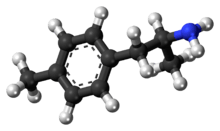4-Methylamphetamine
 | |
 | |
| Clinical data | |
|---|---|
| Routes of administration | Oral, intranasal, injection |
| ATC code | none |
| Legal status | |
| Legal status |
|
| Pharmacokinetic data | |
| Biological half-life | 6-12 hours |
| Excretion | Urine |
| Identifiers | |
| |
| CAS Number |
22683-78-9 |
| PubChem (CID) | 199116 |
| ChemSpider |
172349 |
| ChEMBL |
CHEMBL166183 |
| Chemical and physical data | |
| Formula | C10H15N |
| Molar mass | 149.23 g/mol |
| 3D model (Jmol) | Interactive image |
| |
| |
| | |
4-Methylamphetamine (4-MA; PAL-313; Aptrol; p-TAP) is a stimulant and anorectic drug of the phenethylamine and amphetamine chemical classes.
In vitro, it acts as a potent and balanced serotonin, norepinephrine, and dopamine releasing agent with Ki affinity values of 53.4nM, 22.2nM, and 44.1nM at the serotonin, norepinephrine, and dopamine transporters, respectively.[1] However, more recent in vivo studies that involved performing microdialysis on rats showed a different trend. These studies showed that 4-methylamphetamine is much more potent at elevating serotonin (~18 x baseline) relative to dopamine (~5 x baseline). The authors speculated that this is because 5-HT release dampens DA release through some mechanism. For example, it was suggested that a possible cause for this could be activation of 5HT2C receptors since this is known to inhibit DA release. In addition there are alternative explanations such as 5-HT release then going on to encourage GABA release, which has an inhibitory effect on DA neurons.[2]
4-MA was investigated as an appetite suppressant in 1952 and was even given a trade name, Aptrol, but development was apparently never completed.[3] More recently it has been reported as a novel designer drug.
In animal studies, 4-MA was shown to have the lowest rate of self-administration out of a range of similar drugs tested (the others being 3-methylamphetamine, 4-fluoroamphetamine, and 3-fluoroamphetamine), likely as a result of having the highest potency for releasing serotonin relative to dopamine.[4][5]
More than a dozen deaths have been reported throughout Europe in 2012-2013 after consumption of amphetamine ('speed') contaminated with 4-methylamphetamine.
Since 4-MA has little, if any, desirable psychoactive properties, researchers doubt the substance was sold as amphetamine on purpose. A contaminated precursor, after synthesis yielding a mixture of amphetamine and 4-MA, seems the logical culprit.[6]
- 1-(4-Methylphenyl)-2-aminobutane
- 2-Methylamphetamine
- 3-Methylamphetamine
- 4-Methyl-N-methylamphetamine
- 4-Methyl-N-methylcathinone
- 3-Methoxy-4-methylamphetamine
- 3,4-Dimethylamphetamine
References
- ↑ Wee, S.; Anderson, KG; Baumann, MH; Rothman, RB; Blough, BE; Woolverton, WL (2004). "Relationship between the Serotonergic Activity and Reinforcing Effects of a Series of Amphetamine Analogs". Journal of Pharmacology and Experimental Therapeutics. 313 (2): 848–854. doi:10.1124/jpet.104.080101. PMID 15677348.
- ↑ Di Giovanni, Giuseppe; Esposito, Ennio; Di Matteo, Vincenzo (2010). "Role of Serotonin in Central Dopamine Dysfunction". CNS Neuroscience & Therapeutics. 16 (3): 179–194. doi:10.1111/j.1755-5949.2010.00135.x. PMID 20557570.
- ↑ Gelvin, EP; McGavack, TH (1952). "2-Amino-1-(p-methylphenyl)-propane (aptrol) as an anorexigenic agent in weight reduction". New York State Journal of Medicine. 52 (2): 223–6. PMID 14890975.
- ↑ Wee, S; Anderson, KG; Baumann, MH; Rothman, RB; Blough, BE; Woolverton, WL (2005). "Relationship between the serotonergic activity and reinforcing effects of a series of amphetamine analogs.". The Journal of Pharmacology and Experimental Therapeutics. 313 (2): 848–54. doi:10.1124/jpet.104.080101. PMID 15677348.
- ↑ Baumann, MH; Clark, RD; Woolverton, WL; Wee, S; Blough, BE; Rothman, RB. (Apr 2011). "In vivo effects of amphetamine analogs reveal evidence for serotonergic inhibition of mesolimbic dopamine transmission in the rat". Journal of Pharmacology and Experimental Therapeutics. 337 (1): 218–25. doi:10.1124/jpet.110.176271. PMC 3063744
 . PMID 21228061.
. PMID 21228061. - ↑ Blanckaert, P.; van Amsterdam, Jgc; Brunt, Tm; van den Berg, Jdj; Van Durme, F.; Maudens, K.; van Bussel, Jch (2013-09-01). "4-Methyl-amphetamine: a health threat for recreational amphetamine users". Journal of Psychopharmacology. 27 (9): 817–822. doi:10.1177/0269881113487950. ISSN 1461-7285. PMID 23784740.